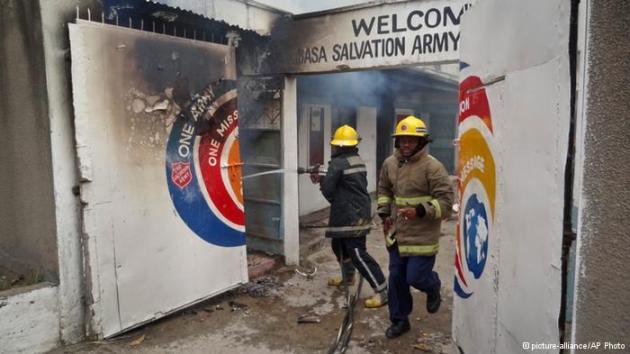International Disaster Response
While The Salvation Army has endeavored to respond to international relief work on a national level since the turn of the century, says Major Roland Sewell, international emergency and refugee services coordinator, the Army has recently become involved in international relief in a new and significant way.
“In 1994, when (then) Commissioner Paul Rader was elected General, the story of the Rwandan genocide was just becoming known. He felt it was important to respond and, consequently, an international team of 10 workers was sent to that country. That was a major change for us,” Sewell explains.
Next came the fighting in Bosnia and, again, the Army responded to meet significant needs in that war torn country. Prior to the relief teams being sent to Rwanda and Bosnia, The Salvation Army did not have a presence in either country.
“We are now doing something we haven’t done before in places we haven’t been before,” says Sewell. The International Emergency and Refugee Services department was formally established in January 1996, with the mandate to resource territories internationally to better respond to crisis.
After a disaster hits, the first step is to complete an on-site needs assessment. “From my experience, The Salvation Army or any international agency for that matter, is rarely able to significantly save lives in the very early stage of a disaster. That happens happens from within the affected community.” What must take place, to prevent further loss of life and ensure lasting recovery, is to assess needs swiftly and competently, determine a plan, and implement it efficiently.
He explains that while all people need shelter, food, water, and medical attention in the early stages of any crisis, the order of priorities in attending to them may differ. Skilled emergency relief can assess those needs and so implement assistance that enhances the capacity of the community itself to ultimately respond, as is the experience in Bosnia. “The question is, how far along the road do we go, in going from disaster response to post-war redevelopment–do we want to be involved in that?” he asks, and then quickly answers his own question: The Salvation Army needs to be involved in all of it. “It’s what the Gospel is all about.”
The Army is also able to provide relief and conduct needs assessments in countries in which it already has a presence. “I’d like the opportunity to demonstrate that we can come in alongside the local Army and assist without overstepping,” he says.
While the Army’s international organization enables it to have personnel and capabilities to respond to disasters, its very size and structure can sometimes create cumbersome channels of communication. Streamlining communication during a disaster would be a positive change.
“Without undermining the line of command, it is essential to communicate directly at an early stage,” he says. “Even with the best of intentions, when going through a third party you can’t be confident the message is getting across and can’t be sure you’re responding accurately.”
The need for teams of volunteer international disaster relief workers is a growing one, both for short (three months) and long (six months to a year) terms. Ideally, having a team of 20 skilled volunteers in each of the five international zones would enable the Army to respond effectively to disasters worldwide. To do so, a database of three to four times that many people, around 3-400, is needed. (See ad on back page.)
The Army is currently working on building such a database. “We are looking for officers, soldiers, and Christians–ideally Salvationists–who would offer to be involved,” he reports. Early this year, each zone was provided with details and requests for volunteers and there are now 150 on file.
In addition to getting volunteers operational “on the ground,” there is also a need to resource territories around the world to obtain guidance, training, and improve networking with other relief agencies and donors.
Networking, in fact, is a growing need for the Army. “In the past, we have seemed to be isolationist,” Sewell says. “It is essential that we network broadly and widely in disaster relief. We must work in partnership with other relief agencies.” Building relationships with other non-governmental agencies in Bosnia, for instance, has played an important role in the Army’s success there.
Funding for international relief comes from a reserve of $150,000 at International Headquarters, which is used to make small contributions to territories when disasters hit; and the international emergency and relief department, which is self-funding. Its $130,000 budget must cover operating costs for the four person office (including travel expenses) and is raised through small levies from projects. “There is a need for stable funding we can count on,” Sewell says, explaining that a “pump priming” fund is needed to provide immediate funds to respond in the event of a disaster.
The funds for this could come from public donations to the Army’s international relief work or from monies solicited from trusts and foundations. An anonymous direct donation of $500,000 from a businessman in the U.S., for example, provided the startup funds for the work in Bosnia, he explains.
While the Army continues to meet needs in Rwanda and Bosnia, it’s certain that before long another disaster will strike somewhere in the world–thus creating additional needs for international relief. With its historic mission of providing physical and spiritual support, its growing bank of trained volunteers, and its increasing skill as a team player with other relief agencies, the Army’s presence in disasters fills a vital need.
“The Salvation Army is as well equipped as any other international organization to respond to disasters,” says Sewell.











